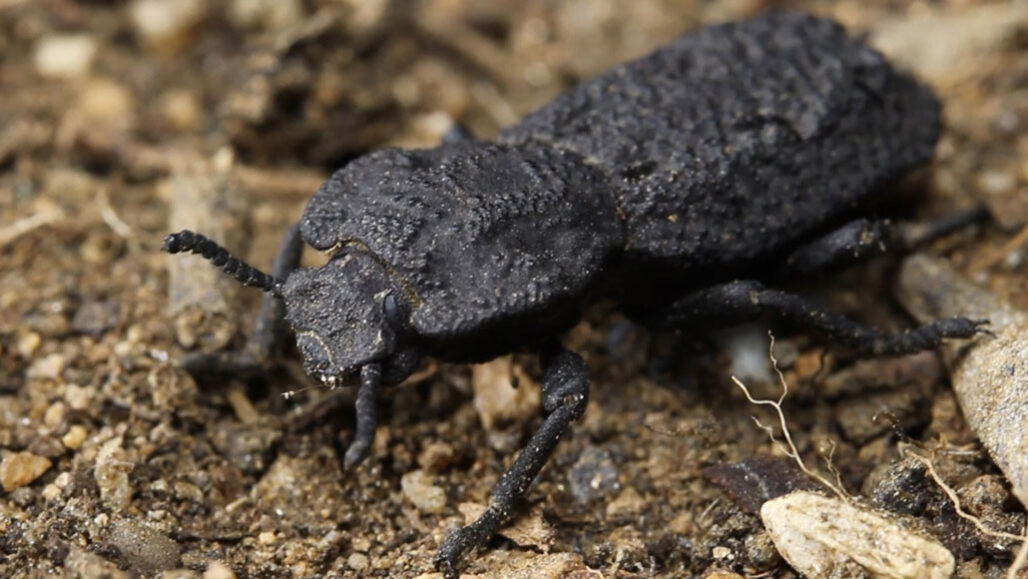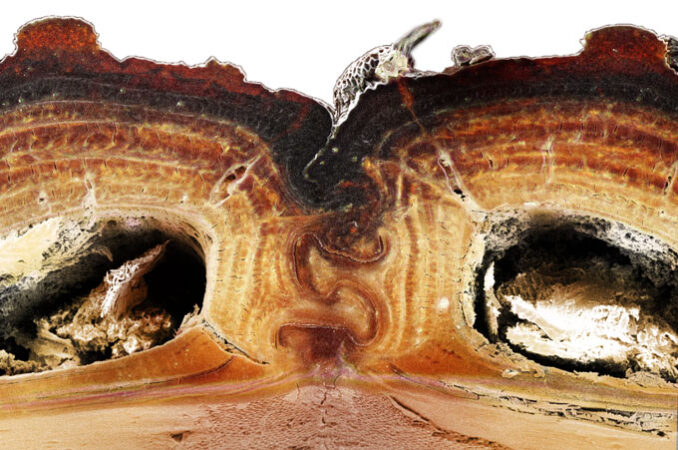The diabolical ironclad beetle is nearly unsquishable
Microstructures in its armor provide enough protection to survive a run-in with a car

The diabolical ironclad beetle looks sort of like a rock — and it’s almost as unbreakable. Thanks to the intricate links between different parts of its exoskeleton, this beetle can withstand getting run over by a car.
David Kisailus
The diabolical ironclad beetle is like a tiny tank on six legs.
This insect’s rugged exoskeleton is so tough that the beetle can survive getting run over by cars. Many would-be predators don’t stand a chance of cracking one of these beetles open. Phloeodes diabolicus is basically nature’s jawbreaker.
A study has now revealed now revealed the secrets of this beetle’s armor. Tightly interlocked and impact-absorbing structures link together pieces of the beetle’s exoskeleton. Those structures help the beetle survive enormous crushing forces. Researchers describe their structure in the October 22 Nature. Those features could inspire new, sturdier designs for things such as body armor, buildings, bridges and vehicles.
The diabolical ironclad beetle dwells in desert regions of western North America. It has a distinctly hard-to-squish shape, notes David Kisailus. He’s a materials scientist at the University of California, Irvine. A stink beetle or a Namibian beetle are more rounded. In contrast, he points out, this beetle is “low to the ground [and] it’s flat on top.”
Kisailus was part of a team that tested how much the beetle’s armor would compress. It can withstand around 39,000 times its own body weight, they found. That would be like a person shouldering a stack of some 40 M1 Abrams battle tanks.
Two key microscopic features help the beetle withstand crushing forces. The first is a series of connections linking the top and bottom halves of its exoskeleton. “You can imagine the beetle’s exoskeleton almost like two halves of a clamshell sitting on top of each other,” Kisailus says. Ridges along the outer edges of the top and bottom latch together.
Near the front of the beetle, around its vital organs, those ridges are highly interlinked. They’re almost like zipper teeth. Those connections are stiff. They also resist bending.
Near the back of the beetle, the ridges are not as tightly interlocked. That allows the top and bottom halves of the exoskeleton to slide past each other slightly. This flexibility helps the beetle absorb compression in a part of its body that is safer to squish.
The second key feature is a rigid joint that runs the length of the beetle’s back. It connects the beetle’s left and right sides. A series of protrusions, called blades, join the two sides. And they fit together like pieces of a jigsaw puzzle. Proteins glue together layers of tissue in these blades. That help make the blades damage-resistant. When the beetle is squashed, tiny cracks form in the glue between the layers of each blade. Those small fractures allow the blades to absorb impacts without completely snapping, explains Jesus Rivera. He’s an engineer at UC Irvine. With time, those fractures also will heal.

This toughness makes the diabolical ironclad beetle pretty predator-proof. An animal might be able to swallow this insect whole, Kisailus says. But if, say, a bird pecked at it or a lizard tried to chew it, that shell would be really hard to crack.
That hard exterior also is a nuisance for insect collectors. The beetle is known for being so durable that it bends the steel pins usually used to mount insects for display, says Michael Caterino. He’s an entomologist, someone who studies insects. He works at Clemson University in South Carolina. “I found it fascinating” to learn what makes the beetle so tough, he says. Its basic biology “is not particularly well-known.” The potential for using beetle-inspired designs for sturdier airplanes and other structures is intriguing, Caterino adds. Who knows what other critters might one day reveal similarly clever examples of natural engineering.







